TKT Core Module 3: Teachers' and learners' language in the classroom
Grouping learners
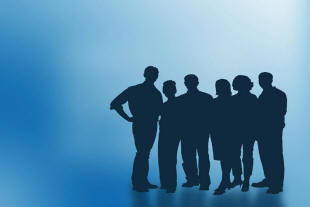 |
Grouping learners is a key planning and management skill. It can be overdone and some learners feel it gets tedious so handle with some care.
 |
Key concepts in this guideBy the end of this guide, you should be able to understand and use these key concepts:
|
Look out for these words like this
in the text.
There will be tests at the end of the guide for you to check that
you understand the ideas.
 |
Why group learners at all? |
There are a number of advantages to grouping students at various times in most lessons. They include:
- maximising speaking practice for the learners
- varying interactions to maintain energy levels and interest
- getting people moving about
- encouraging peer-correction and collaboration
- taking the focus off the teacher and putting it on the learners
- appealing to people with strong interpersonal intelligence
- lowering the stress levels by limiting the number of people the learners address
- giving learners practice in understanding other learners (teaching English as a lingua franca)
Matching grouping to task type
Consider these 10 arrangements of learners and try to say what could be happening in each arrangement.
Click on each image for an answer.
 |
pairs working together on a task they can both see easily
|
 |
collaborating on a task in a group of 4 or interviewing each
other
|
 |
pairs interviewing each other or exchanging ideas
|
 |
students mingling to find someone who ...
the teacher could be anywhere in the room this can vary with one student talking to two, two to two and so on |
 |
discussing in fours
note the lack of a table to make it easier |
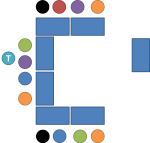 |
whole-class pair work with the teacher assisting one pair
the teacher can also (arguably should) assist from the other side of the table and make eye contact sitting / crouching |
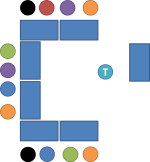 |
teacher presentation or getting / giving feedback from / to the whole class
everyone can see everyone |
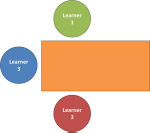 |
collaborating
on a task in threes
|
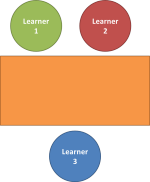 |
2 students interviewing one or vice versa
|
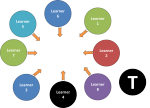 |
whole-class discussion (teacher standing out)
|
There is more on this in a guide on this site to classroom arrangement. Here we are concerned with the reasons for choosing between possible arrangements.
The fundamental distinction is between
- tasks which require people to collaborate (such
as working together to answer questions on a text, reading a text
and helping each other understand, writing a paragraph together,
planning a presentation, coming up with lists of characteristics and
so on).
These sorts of tasks usually involve the need for a desk or table to work at and it's frustrating for learners if they have to balance papers on their knees. - tasks which require people to confront each
other in some way (such as interviewing each other, discussing a
problem or playing some kind of role).
These sorts of tasks need a different arrangement in which people are arranged face to face rather than side by side and can be set up with a table between them (which increases social distance) or without (which removes a filter to communication).
It's a simple process to classify all the arrangements in the diagrams above. Try it.
 |
Group- / pair-work tasks |
Here's an (incomplete) list of the sorts of tasks often (not always) best done in pairs or groups.
- speaking tasks
- role plays (social setting, commercial transactions, advice
giving etc.)
interviews (tell me about, tell me what you think about etc.)
discussions (in groups of more than two, probably)
pair work in threes (two learners talk, the third listens and takes note of uses of the target items, ways of taking turns / giving feedback to each other etc.) - writing tasks
- constructing a dialogue using target items
planning a piece of writing by brainstorming things to say and the order in which to write them
writing lists and prioritising lists - structural / lexical tasks
- noting differences in meaning between sentences with different
structures
gap fills
sentence completion tasks
lexis matching tasks (item to picture, item to definition etc.) - reading tasks
- reading two different parts of a text each and then exchanging
the ideas and facts
reading information and making collaborative decisions about choices (holiday brochures, course descriptions, entertainment guides etc.)
reading part of a story and speculating about what happens next before reading the next part to see if the guesses were correct - listening tasks
- listening to a song / piece of music and comparing reactions
listening to an announcement and deciding who in the group it applies to
listening to each other telling a story and giving feedback
When not to group students
Please don't assume from any of this that pair- or group-work is
always preferable. There are times when it is both appropriate and
important that the whole class works together or individuals work alone.
For example, if the nature of the activity is to allow individuals to
see if they have grasped the target of the lesson and can put it into
practice, it's actually inappropriate to carry out the task in
groups or pairs.
Silent reading, too, is usually done, authentically, alone, and getting
learners to read the same text together is arguably not a useful
exercise.
It is for you to
decide what you want the activity to achieve and then choose the best
way of conducting it.
 |
The teacher's role |
The other consideration here is where you should be and what you should be doing. Again, there are distinctions
- Is the nature of the activity one in which people are actually
learning the target language or skill?
If it is, you will need to make sure you can get involved. Your job is to support the learners in their efforts, to assess how well the targets are being learned and to intervene when things go off track.
Look at the arrangements above and note the ones which involve the teacher. - Is the nature of the activity one which simply prepares people
to go on to the real learning phases of the lesson? That is to
say, an activity whose outcome is less important than the process of
doing the task.
These tasks usually come early in a lesson and require the learners to exchange current ideas about a topic or to discuss views and see what they already know.
In these sorts of activities you need to know what's going on in a general way (so you can highlight interesting ideas and thoughts in a feedback phase) so you need to listen carefully and wander around but you do not want to be intrusive or interruptive. - Is the nature of the task one in which you need to address
everyone, either to present or to get / give feedback?
Activities like this require you to be able to make eye contact with and see everyone in the group so you need to be where that can happen. There is one arrangement above which allows for this. It also allows for people to see everyone else in the group and that keeps people involved.
Take the time

- It is not a waste of time spending some of it making sure that an activity is properly set up and that the groupings are arranged in a way that makes the task easy to achieve. It's also worth remembering that most people actually like to get up and move around at times.
- Be clear in your planning stage how you want people to sit or stand depending on the nature of the activity you have devised. Add the description into your lesson notes so you don't forget to (re-)arrange the learners and the room accordingly.
- Become expert at setting activities up quickly and efficiently so that your learners gain the
most benefit and the arrangement does not actually hinder them.
This usually means being slightly assertive (no, not rude) with
instructions such as
Mary, John and Peter. Please sit here, here and here
or
Right. Everyone. Move the tables back and come round into the front now, please.
Do not be vague with 'instructions' such as
Be sure you can talk easily
or
I wonder if you'd like to move over here.
Those aren't actually instructions at all.
 |
Self-test questions |
Before you go on, make sure you can answer these questions. If you can't, go back to the sections which give you trouble.
- Explain why we sometimes group learners.
- Explain the difference between a collaborative and a confrontational task.
- What difference does this make to how people are sitting?
If you are happy with your progress, go on.
 |
Tests and practice for TKT |
There's only one practice test.
| Test 1 | A matching task |
Now you can return to the Module 3 index:
![]()
or go on to the next
guide which is to
correcting learners.
